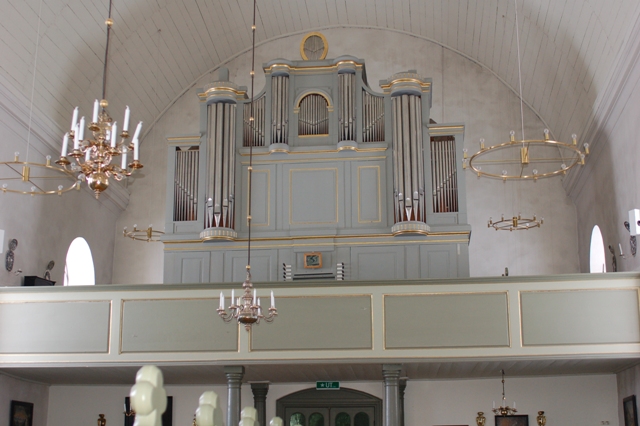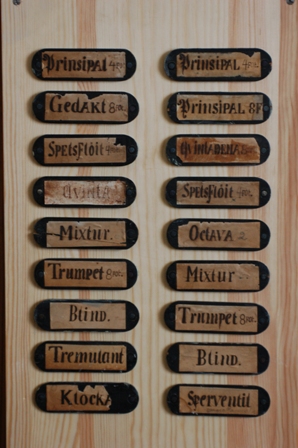
Tryserum Church in northeast Småland is one of the finest of the many neo-classical parish churches built during the latter part of the eighteenth century, primarily in Östergötland and Småland. It was designed by Jean Eric Rehn, one of the foremost architects of his day, and financed largely by the squire of the congregation, Count Gustaf Horn of Fogelvik Manor.
The architecture is simple and magnificent with a tower in the west, white plastered walls with large windows and a half-round choir with the Horn and Gyllenstierna family sepulchres below the floor. The interior is a single large, open room covered with a high barrel vault, characterized by light, space, and an acoustic well suited to both speech and music
The bishop of the diocese, Uno von Troil, officiated at the dedication of the church on October 9, 1785. Among the guests was Baron Israel Lagerfelt, a friend of Gustaf Horn and active as an organist and organ expert. The ceremony began by striking up the new organ together with the artillery regiment band of Småland, after which the hymn "Praise the Lord, each tribe and nation" (Hela världen fröjdes Herran) was sung.
The organ had been built by the organbuilder Pehr Schiörlin in Linköping. Like Olof Schwan in Stockholm, he was one of the foremost organbuilders in the country. The choice of Schiörlin must have been a natural one, since he was active within the diocese of Linköping, but one can probably assume that Israel Lagerfelt, who had collaborated closely with Schiörlin, recommended Schiörlin for his friend Horn’s organ project.
Pehr Schiörlin was born in Svärta parish in Södermanland, where his father worked as a carpenter. At age 11, he moved to Linköping, and by age 17, he was apprenticed to the organbuilder Jonas Wistenius. Wistenius, who was a farmer’s son from Vist parish south of Linköping, had worked for 12 years for, among others, the famous organ builders Johann Josua Mosengel and Georg Sigismund Caspari in Königsberg, in north Germany, before he established himself in Linköping. Pehr Schiörlin became a loyal member of Wistenius’ very productive workshop. In 1763, after a long period as first journeyman, he became Wistenius’ partner, and he took over the workshop after Wistenius’ death in 1777. In 1778 he passed the organbuilder’s examination of the Royal Academy of Music. He then ran the workshop until his death in 1815, by which time he had built more than 70 organs, of which fifteen are preserved in playable condition. In the country churches these were mostly small organs with about ten stops, one manual and a pull-down pedal, but Schiörlin also built several larger organs with two manuals and independent pedals. The most famous is the very well-preserved 26-stop organ from 1806 in Gammalkil Church near Linköping. (See Loft Recordings LRCD 1026).
The contract with Schiörlin for the organ in Tryserum’s new church was signed at Fogelvik on June 31, 1783. It is for an organ with one manual with eight stops and an independent pedal division with five stops. The specification was eventually enlarged, however, to include a Principal 8' diskant and two empty stops, doubtless for a Vox humana 8' diskant and Trumpet 4' bas. A Subbas 16' was built in the pedal division instead of the Octava 4' that had been contracted for. The keyboard, the metal pipes and the shallots of the reed pipes were to be made in the workshop, and the remaining parts, including the windchests, the wooden pipes, and the other wooden parts, at Fogelvik, where Schiörlin and his journeymen were also to receive room and board. This means that the organ must have developed in close collaboration with the musical Gustaf Horn, which perhaps explains why the organ came to be built on a more ambitious level than the contract describes.
The organ in Tryserum was built when Schiörlin’s organbuilding career was at its peak. Using Wistenius’ North German organ style as a point of departure, he had developed his own, highly personal style, one that was stately, but also brilliant and lyrical. The principals, flutes and reeds offer a rich spectrum of sound. It is characteristic of Schiörlin’s work from this point on that he often gives his 4' divisions an 8' principal in the treble, and that the principal choir includes a colourful "terz mixture", often divided into two sliders with one or two octave ranks in one and third and fifth ranks in the other. There is usually a Vox humana 8' in the treble even in the small organs, but for some reason, Tryserum did not get a Vox humana, only a prepared place for one. The contract specified that the façade was to be executed according to drawings by the Office of the Court Surveyor, but it seems rather that it was drawn by Schiörlin himself. The façade clearly reflects the organization of the divisions, with a manual division placed high in the case with the Principal 8' diskant in the middle field and the Principal 4' bas in the towers, flanked by the pedal division with its Principal 8'.
That Gustaf Horn himself was both interested and knowledgeable is clear from the comments he appended when he handed in the drawing of the organ to the Surveyor’s Office for due approval: he did not wish any changes to the proposal since "I have taken great pains as a musician to have the pipes placed in such an order that the organ will have the best effect." Perhaps Schiörlin had warned him about the ambitions on the part of the Surveyor’s Office to rework organ plans with the intentions of fulfilling the requirement of good and modern architecture. The result was often that organbuilders, for architectural reasons, had to use dummy pipes in the façade and place the treble pipes of the principal stops inside the organ.
After more than 200 years, the organ is still in good condition. Minor repairs were carried out in 1799, 1848, and 1898, when the organ was given a new pedal keyboard and new bone covers on the natural keys. The specification was changed in 1913 by J. Thunberg. The Quinta 3' was moved to a Vox retusa 8' Diskant, the Quintadena 8' was altered to a Fugara 8'; part of the mixture was moved, and both sliders were linked together in a single stop. The changes were reversed during a restoration by organbuilder Magnus Fries in 1968.
During 2005 and 2006, the organ was restored according to a program drawn up by organ antiquarian Niclas Fredriksson. In addition to a technical repair, certain aspects of the voicing were restored, especially in the mixture. The pedal keyboard from 1989 was replaced with a reconstruction from a model by Schiörlin, and the manual keyboard was given new covers, also reconstructions. The organ was tuned using Schiörlin’s normal temperament (nearly identical to J.G. Neidhardts "Für ein Dorff"). A complete documentation of the organ was carried out by Niclas Fredriksson with the assistance of Alf Åslund of the Göteborg Organ Art Center (GOArt).
Sources:
• Einar Erici and Axel Unnerbäck Orgelinventarium. Bevarade klassiska kyrkorglar i Sverige. Stockholm 1988. Stockholm 1988
• Niclas Fredriksson Projektbeskrivning för restaurering av Schiörlinorgeln i Tryserums kyrka, Linköpings stift. Manuscript 2002.
• Documents from the archives of Tryserum Church in the Vadstena Record Office (Vadstena Landsarkiv); from the Lagerfelt archive at Lagerlunda Manor, Östergötland; and from the Fogelvik archive in the Västervik district (Västerviks kommun).
• Personal communications from N. Fredriksson
• N. Fredriksson’s technical-historical documentation will be published in the fall of 2006 by the Swedish National Heritage Board (Riksantikvarieämbetet).
– AXEL UNNERBÄCK ( TRANSLATED BY ROBIN BLANTON)  MANUAL C-f 3
Principal 8' Discant only, c1 – f 3; c1–ciss2 in the façade
Principal 4' B/D, h0/c1; C- ciss0 in the façade
Gedagt 8'
Quintadena 8'
Spitzfleut 4' B/D, h0/c1
Quinta 3'
Octava 2'
Mixtur IV cc/eg, 1'+ 1-4/5'+ 2/3', octave repetition at c1 and c2
Trompet 8' B/D h0 / c1; wood and metal
Tremulant
PEDAL C- c1
Untersats 16' wood, open
Subbas 16' wood, stopped
Principal 8' C-h0 in the façade
Basun 16' wood
Trompet 8' wood and metal
Pitch: Chorton (a1= ca. 462 Hz at 18° C)
Temperament: J. G. Neidhardt 1724 "Für ein Dorff" (identical to "Für eine kleine Stadt" 1732)
Bellows: two wedge bellows
Wind pressure: 70 mm vp.
|